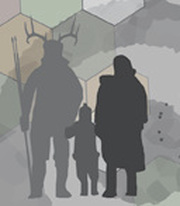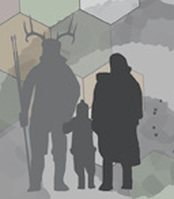 Amelia Island, Florida: not the home of a giant skull with three rows of teeth.
Amelia Island, Florida: not the home of a giant skull with three rows of teeth. "I think what is written above is a good skeptical attempt, and i think some people may need an "out" door, any will do. There is simply more room for a double row of teeth in a person whose skull is abnormally thick (Concord, New Hampshire) as in many accounts. These jaws are said to be able to slip over the head of a full grown man and perfect all the way around in many accounts. I think its dishonest to assume some alternative to the semantics of a few (teeth were double) and assume intent of the writer. While so many other articles Like the finds in Amelia Island that not only that two skulls are said to have two rows of teeth, One of the skulls from Florida is said to have 3 rows of teeth. No explanation necessary, i will chose option 5) The author's rebuttal is cherry-picking. This research has been done by a handful of us giant-researchers now there is too many to count. For my part: by next year i will double the accounts that are available now. (with double rows of teeth) GAWM"
The acronym “GAWM” stands for Greater Ancestors World Museum, which Lesley runs. The GAWM website has the following statement about the Amelia Island skeletons:
"Amelia Island Skulls with two rows of teeth
Amelia Island is practically in my back yard, about 40 miles from my location, so this story strikes a higher interest level for me. On Amelia island multiple burial mounds were found containing skeletons, and artifacts. Out of the hundreds of skeletons only perfect teeth were found.
A skull was found on the island that i hope to replicate with some information. An extremely large skull with perfect teeth, and perfectly preserved was found on the island a massive skull with two rows of teeth, and one with three rows. The third set being the start of a nucleus of a tooth. The skull was dry, not filled with soil in the cavities, perfect and complete.
Within a short time span of a couple of hours the skull crumbled to dust upon exposure to air."
Spoiler alert: there is no “massive skull” with “three rows of teeth” described among the Amelia Island skeletons. Lesley has mixed up different parts of the account and misinterpreted/misrepresented a description of an unusual, unerupted supernumerary tooth as “three rows of teeth.”
Lesley is referring to a description in the 1874 Annual Report of the Board of Regents of the Smithsonian Institution (available here). The following is a transcript of the paragraph about the teeth of the Amelia Island skeletons by Augustus Mitchell in a section titled “Antiquities of Florida” (pages 391-392) [number 440 in my database]:
“The teeth of many of the crania of this mound were, without exceptions, in a perfect state of preservation, the vitrified enamel of these organs being capable of resisting exposure for centuries. These teeth presented distinctive appearances throughout, in the absence of the pointed canines; the incisors, canine, cuspides, and bicuspids all presented flat crowns, worn to smoothness by the attrition of sand and ashes eaten with the half-cooked food. A bi-section of some of these teeth showed the dental nerve to be protected by an unusual thickness on the surface of the crown. Not one carious tooth was found among the hundreds in the mound. Many were entire in the lower jaw, the whole compactly and firmly set. In some the second set was observed; while one jaw had evident signs of a third set, a nucleus of a tooth being seen beneath the neck of a tooth of a very old jaw, whose alveolar process was gone, and the whole lower jaw ossified to a sharp edge; none showing the partial loss of teeth by caries and decay.
. . .
Pursuing my investigations, and excavating further toward the southeast face of the mound, I came upon the largest-sized stone ax I have ever seen or that had ever been found in that section of the country. Close to it was the largest and most perfect cranium of the mound, not crushed by the pressure of the earth, complete in its form, quite dry, and no sand in its cavity; together with its inferior maxillary bone, with all the teeth in the upper and lower jaws. Near by the side of this skull were the femoris, the tibia, the humerus, ulna, and part of the radius, with a portion of the pelvis directly under the skull. All of the other bones of this large skeleton were completely or partially decayed. Contiguous to this was nearly a quart of red ocher, and quite the same quantity of what seemed to be pulverized charcoal, as materials of war-paint. Anticipating a perfect specimen in this skull, I was doomed to disappointment; for, after taking it out of the earth and setting it up, so that I could view the fleshless face of this gigantic savage, in the space two hours it crumbled to pieces, except small portions. According to the measurement of the bones of this skeleton, its height must have been quite 7 feet.”
Two major discrepancies are notable between the 1874 description and Lesley’s characterizations of it. First, the account says "third set of teeth," not "three rows of teeth. Those are not the same thing. Second, the "largest and most perfect cranium" is not the one with the "third set of teeth."
The Accounts Says “Third Set” of Teeth, not “Three Rows of Teeth”
First, nowhere in account does Mitchell describe a skull with three “rows” of teeth (or two rows of teeth, for that matter). On page 392, he writes (emphasis added):
"In some the second set was observed; while one jaw had evident signs of a third set, a nucleus of a tooth being seen beneath the neck of a tooth of a very old jaw, whose alveolar process was gone, and the whole lower jaw ossified to a sharp edge; none showing the partial loss of teeth by caries and decay."
The use of the word “set” is the key here. The term “second set” refers to the permanent teeth (as opposed to the “first set” or deciduous or “baby” teeth). His reference to a “third set” is very specific, and involves observation of a single “nucleus of a tooth” that can be seen beneath the neck of one of the permanent teeth. This “nucleus of a tooth” can only be seen because the alveolar process (the bone surrounding the teeth) was damaged, allowing an observer to see the roots of one of the permanent teeth. The “evident signs of a third set” of teeth was a tooth developing among the roots of a permanent tooth. This was noteworthy because it is not common for “new” teeth to develop after eruption of all the permanent teeth. As is shown by the quotes below, however, the phenomenon was not unknown.
The following passages from The Pathology of the Teeth (1872) by Carl Wedl (available here) illustrate use of the term “set” to describe the succession of deciduous and permanent teeth and show what is meant by a “third set” of teeth (emphasis added):
"The second upper molars not unfrequently make their appearance before the corresponding lower teeth. With these, the first set of teeth, the milk or deciduous set is completed, generally by the end of the second, or occasionally not until the end of the third year" (pg. 74).
"SECOND DENTITION.—The eruption of the first molars ushers in the shedding of the teeth. They appear in the seventh year . . ." (pg. 76)
"THIRD DENTITION.—The possibility of the occurrence of a third dentition is doubted, and even openly denied by many. Its opponents assert that cases of presumed third dentition are merely instances in which the teeth have not emerged, but have remained imbedded within the jaw until the occurrence of senile resorption of the alveolar processes. Deceptions may easily occur in regard to them, particularly among the ignorant, as well be evident from reference to the section upon the retention of teeth. On the other hand, however, we ought not to persist in the denial of the occurrence of a third dentition, on the ground that it is contrary to the current physiological doctrines.
The writers of former times,* Aristotle, Eusachius, and Albinus, mention a repeated renewal of the teeth. In recent times, Fauchard, Bourdet, J. Hunter (the latter observed a third set of teeth in both jaws), Van Swieten, Haller, collected several such cases from different writers. Hufeland describes a case which came to his knowledge. In the one hundred and sixteenth year of life, new teeth were said to have made their appearance; six months after the loss of these, new molars appeared in each jaw. Serres observed two cases in the Hopital del Pitie; one of a man thirty-five years old, who two lower central incisors fell out, and were replaced after a few months; the other of a man seventy-six years old, who, during convalescence from a bilious fever, experienced pain and swelling in the gum of the under jaw, which disappeared on the eruption of a tooth with several eminences in the place of the second molar on the left side. The margins of the alveoli had not yet disappeared in this old man.
C. A. Harris has no doubt that a third dentition does occur in extremely rare cases, and instances a number of examples where individuals, who for a long time had been toothless, acquired several teeth, or even an entire set, in extreme old age. . . ." (pg. 87)
Wedl continues with his discussion of purported cases of “third dentitions” and teeth erupting very late in life. Though an oddity (and a controversial one), there was nothing supernatural about these cases. These were normal people with somewhat anomalous dental characteristics.
Here is other example of the use of the term “set” from the 1894 book The Anatomy and Pathology of the Teeth by Carl F. W. Bodecker (available here) (emphasis added):
"The Temporary, Deciduous, or Milk Teeth.--In the mouth of an infant, about the sixth month after its birth, we observe the appearance of the first teeth, which belong to the so-called “temporary” or “deciduous” set" (p. 22).
"Originally, the temporary teeth, like those of the permanent set, are possessed of roots which gradually become shortened by absorption, as the growth of the permanent teeth proceeds" (p. 264).
And again, from the 1896 book Dental Pathology and Practice by Frank Abbot (available here):
"The term “children’s teeth,” as here used, refers more particularly to the temporary or deciduous set, which are twenty in number . . ." (p. 90).
"It must be remembered that the permanent set of teeth—those that are to take the places of the temporary ones (ten in each jaw)—depend almost entirely for their regularity upon proper care and timely removal of the temporary teeth" (p. 92-93).
It is pretty clear to me that, in his description of the Amelia Island skeletons, Mitchell was simply saying that many of the skeletons had their permanent teeth (“the second set” or the "second dentition") and therefore were adults. This was worthy of noting because of the low incidence of tooth decay that he observed (which was higher in the living populations at the time). He noted the lack of tooth decay and specified that that the population contained adults rather than children (who would have naturally had a lower incidence of caries). This goes along with his discussion of the wear of the teeth (which is a great example of a wear pattern that could have easily been called “double teeth all around” if this was a less formal description in, say, a newspaper).
Mitchell mentioned a particular incidence of an unerupted tooth that was developing beneath a permanent tooth because it was an oddity. In no way was he saying that the skull had "three rows of teeth." Lesley is misinterpreting and/or misrepresenting what Mitchell said in his description.
The “Massive Skull” Did Not Have a “Third Set” of Teeth
Second, Lesley has combined different parts of Mitchell's 1874 description to make it appear as though the largest skull had "three rows of teeth." On his website, Lesley states that:
"A skull was found on the island that i hope to replicate with some information. An extremely large skull with perfect teeth, and perfectly preserved was found on the island a massive skull with two rows of teeth, and one with three rows. The third set being the start of a nucleus of a tooth. The skull was dry, not filled with soil in the cavities, perfect and complete."
This is a jumbled up statement that equates "set" with "rows" and leaves the impression that there was a single large skull with three rows of teeth. That's simply not true.
As is plainly evident from the 1874 description supplied above, the “extremely large skull” is not the one with “three rows of teeth.” Mitchell (1874:392) states that the “largest” skull (to which Lesley is referring) had “all the teeth in the upper and lower jaws.” The skull with a “third set” of teeth, however, was described as missing most or all of the teeth on the mandible (“and the whole lower jaw ossified to a sharp edge”). These are not the same skulls: one has teeth in the mandible (lower jaw) and one does not. It doesn't take a nuanced reading of the account to figure that out.
What the Giantologists Got Wrong
There is no “massive skull” with “three rows of teeth” described among the Amelia Island skeletons. Lesley has mixed up different parts of the account and misinterpreted/misrepresented a description of an unusual, unerupted supernumerary tooth as “three rows of teeth.”
Why does Lesley conflate the two descriptions and interpret a clear description of a single supernumerary tooth as "three rows of teeth"? That’s a question for him to answer. Maybe he’ll clear it up for us here. I can only speculate based on what he's told me on Facebook. I suspect he mixes up the two parts of the account because he really wants there to be a “giant” skull with multiple rows of teeth near where he lives. Again, I'll let him explain why the existence of such a skull would be important. There isn’t such a skull described in the 1874 accounts from Amelia Island, however.
I'm not sure how you create a "replica" of something that never existed. I will look forward to seeing Lesley’s planned "replication." Maybe he will post a picture of it so we can all compare its details to Mitchell’s description.
I also look forward to Lesley's explanation, if he wishes to provide one. I interacted with him briefly on Facebook, but quickly decided it would be more useful to have those interactions in a place where they were open for others to see. I'm under no illusions about changing Lesley's mind about anything. Having a discussion in public, however, opens the possibility that I might be able to change someone else's mind about the validity of some of these claims.


 RSS Feed
RSS Feed
